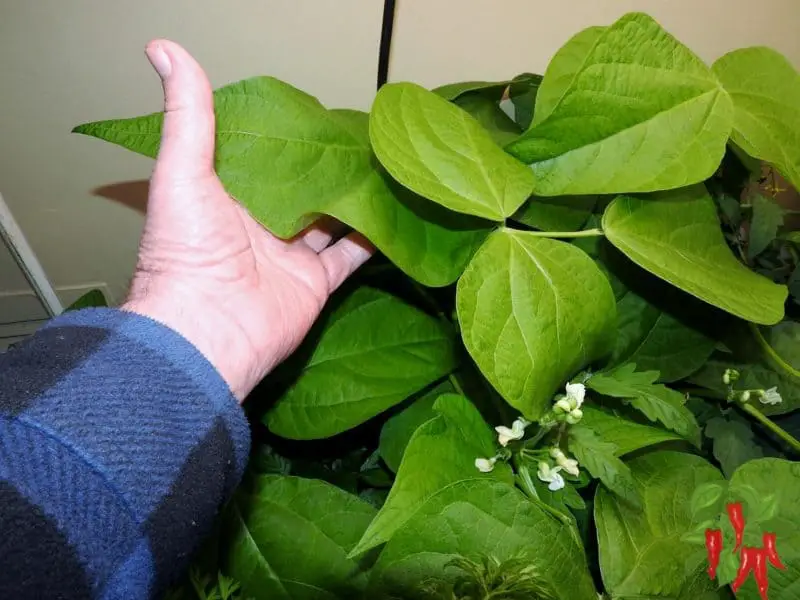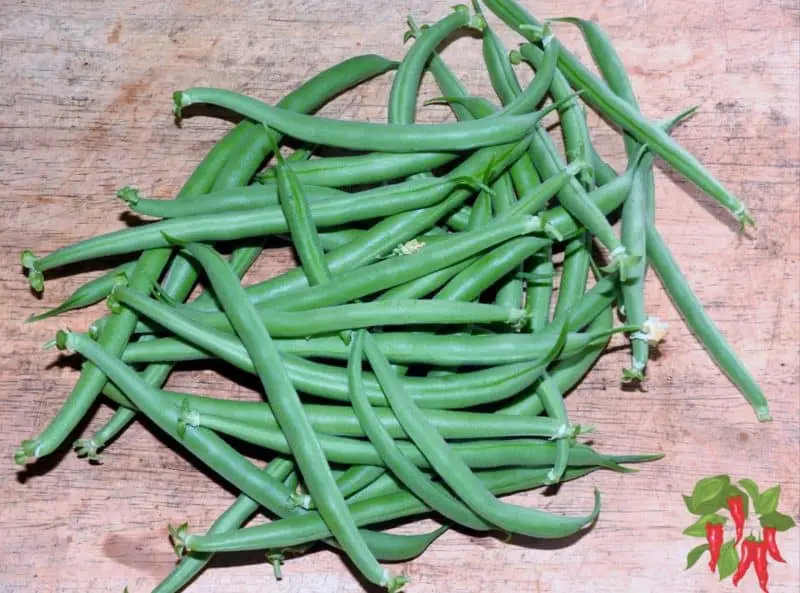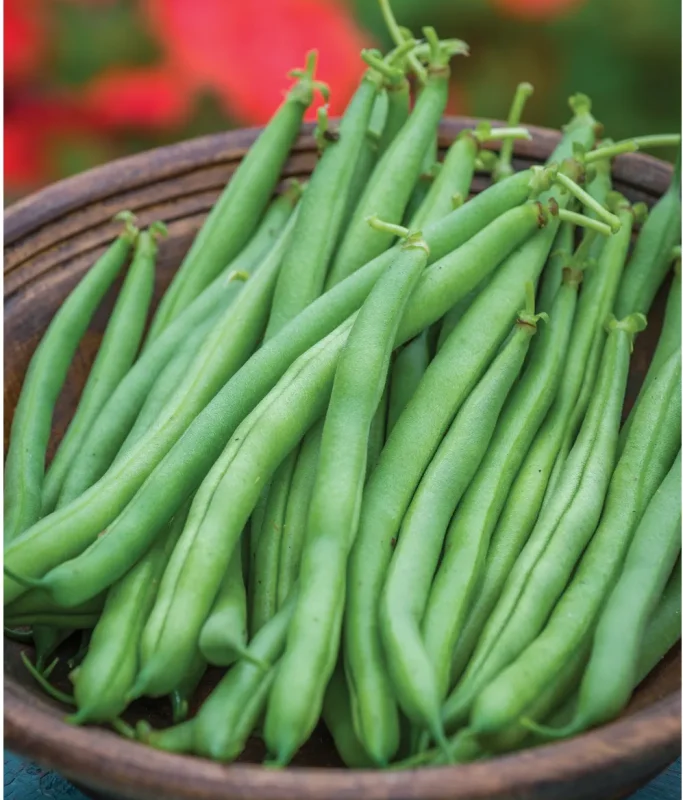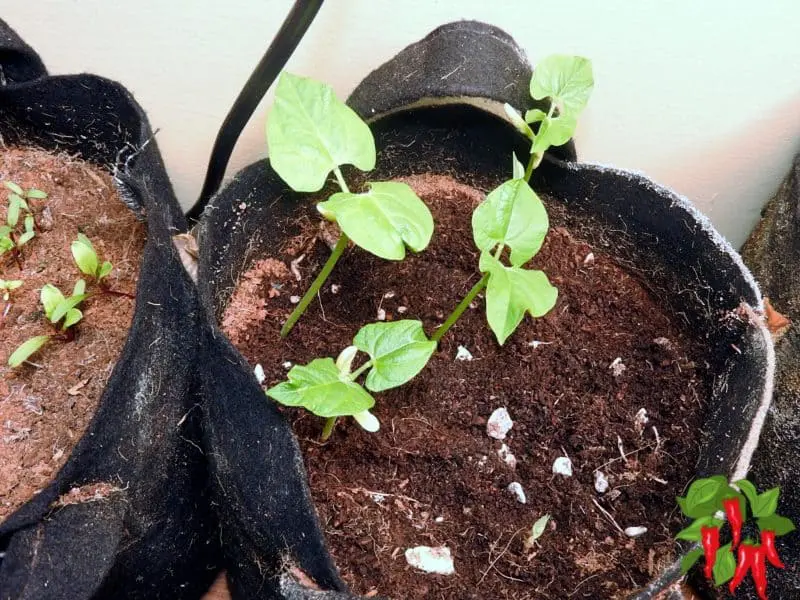This post contains affiliate links. If you buy something from one of our links we may earn a commission. Thanks
Grow your own food at home with ease! Learn the simple steps to growing green beans in pots indoors. From choosing beans to harvest, we’ve got you covered!
Growing Green Beans Key Takeaways:
- Growing green beans in pots is a simple and rewarding experience.
- Choose a wide, 6-8 inch deep pot and quality potting soil.
- Bush beans are ideal for containers, needing just 3-4 inches between plants.
- Ensure at least 6 hours of sunlight or use LED grow lights. Harvest in 50-60 days.
Whether you call them green beans, string beans or snap beans you can start growing green beans in pots indoors.
Even if you don’t have an outdoor garden they do very well indoors and make an attractive house plant that feeds you too.
Why Grow Green Beans?
If you’re looking for a fun, simple way to grow your own food indoors, look no further.
They make attractive houseplants that can also help you get your bean fix.
Growing green beans in containers indoors is an easy-to-grow indoor vegetable once you learn how to take care of them.
You can actually start growing green beans in pots right in the comfort of your own home.
Not only do they make for an eye-catching houseplant, but they’ll also feed you! So, what’s stopping you? Let’s dig in!
Growing Green Beans In Pots Bush Vs Pole Beans
Before we start growing beans in pots we will need to choose what kind of green bean plants to grow.
There are 2 main types of bean plants. One is a bush bean that stays short and the other is pole beans. Pole beans require a trellis.
Garden beans whether bush or pole is Phaseolus vulgaris species but there is another species Phaseolus coccineus known as runner beans.
They are similar to pole beans but are shorter. They also have red flowers and grow better in cool climates.
They also have salmon and other colored flowers and are often grown as ornamentals.
Obviously, pole beans were what Jack In The Beanstalk climbed. Hopefully, if you grow them there are no giants in your apartment.
You will probably want to grow bush beans if you live in an apartment. They produce faster than pole beans.
Pole beans can get 6-10 feet tall so unless you want to provide a trellis bush beans are your best bet.
However, although pole beans take longer to mature they produce over a more extended period of time.
Bush beans produce most of their crop at the same time. They get about 12-18 inches tall and because they are not on a trellis the pots can be moved around.
There are many different types of beans available. Wax beans are pale green and have a unique flavor. There are purple beans too.
Dragon Tongue beans are striped purple and can be eaten fresh or matured and used as shelled beans. There are even bush lima beans.
Interestingly the term string beans came about because they had a tough string running along the pod. But this trait has been bred out of most modern varieties.
How To Grow Bush Beans In Containers
Before we can start growing beans indoors we have to make sure they have enough light.
Beans like growing in full sun so unless you have a balcony that gets at least 6 hours of sun you will need supplemental lighting.
Growing Green Beans Under Lights
LED grow lights are affordable and provide a light spectrum that will help your plants thrive.
They don’t put out as much heat as other types of plant lights and they deliver more light per watt used than any other lighting.
They last for years and come in different sizes allowing you to light just one plant or a group of plants.
I am using a Spider Farmer SF 2000 LED light in my 2×4 foot garden you can see it here on Amazon or read my review. Spider Farmer SF2000 Unboxing And Review (indoorvegetablegrower.com)
Growing Beans In Containers
There are several types of containers you can use to grow beans. You can use plastic pots but I think fabric pots work better.
Bush beans are not deep-rooted plants and can grow in 6-8 inch deep pots. So I would choose a wider pot rather than a taller one.
You will be able to plant several plants in each container so wider containers will give you more beans than narrower taller ones.
What Soil Mix To Use In Your Containers
You can use any potting soil to grow beans. I prefer coco coir for my indoor vegetables. It is a renewable and reusable resource.
It is half the weight of potting soil, provides better drainage, and holds water well while still allowing good oxygenation for the roots.
Some potting soil already includes fertilizer but coco coir needs to be fed with nutrients.
Planting Beans In Pots
Bush beans can be planted 3 or 4 inches apart in containers. So how many plants you have will largely depend on the size of your pot.
Because pole beans are trained up a trellis they can actually be planted even closer at 2 inches apart.
Fertilizing Green Beans
All beans are legumes. Legumes actually put nitrogen into the soil through nodules that grow on their roots.
So beans will probably not need a fertilizer high in nitrogen. They will need a higher amount of potassium and phosphorus.
I have found that beans need healthy levels of calcium and magnesium to perform well. If you notice your leaves turning yellow they may be deficient.
I will be growing Burpee Blue Lake 47 Bush Beans indoors in 2-gallon fabric pots. I have planted about 8 seeds in each container.
If you want to try them they are available on Amazon here.
When they come up I will begin updating their progress in this article. I may need to thin them out a bit.
According to Burpee, they are 15 inches tall and have about a 10-inch spread, and make 6-inch long beans.
Growing Green Beans In Fabric Pots
Recently I planted some Blue Lake bush beans in a 2-gallon fabric pot filled with coco coir.
After about 10 days they started coming up. Germination has been uneven for all seeds. I think I may have gotten older seed packs.
But there are more than enough plants to fill the fabric pot. You can also see some beet seedlings on the left side of the picture.

Blue Lake 47 Bush Beans Monster Leaves
This Blue Lake 47 bush bean has the largest leaves I have ever seen on a bean plant. They are bigger than my hand.

There are 2 or 3 plants in a 2-gallon fabric pot filled with coco coir and bottom watered.
Looks like I will be eating green beans before too long.
Blue Lake 47 Bush Beans Monster Leaves Video
Harvesting Green Beans

So I have just harvested some bush beans today. This plant took up so much space I raised it up with plant yoyos.
It also was drinking so much that I waited a bit too long to water it. I lost a few leaves but no real damage was done.
Here is an updated video of my kitchen garden. It’s crowded right now but soon some pots will be harvested.
FAQs
So you’ve got questions, huh? No worries, we’ve got answers! From the types of beans best suited for pots to how often you should water them, our FAQ section has you covered. These tips will have you harvesting your own tasty green beans in no time.
How long does it take for green beans to grow?
Most green beans will produce a crop in 50-60 days. to keep them producing longer pick off the beans regularly before the pods are showing seed bumps.
What are the best beans to grow in containers?
Bush beans will be best for containers. They are compact and won’t need staking or a trellis like pole beans do.
Blue Lake bush beans are the most popular variety and seed companies offer different variations of the plant.
Q. What kind of soil should I use for growing beans in pots?
A. Any quality potting soil works, but coco coir is a great option. It’s light, drains well, and is a sustainable choice. Just remember to add nutrients since coco coir doesn’t have any.
Q. Do I need to fertilize my green beans?
A. Beans are legumes and add nitrogen to the soil themselves. However, they do benefit from added potassium and phosphorus. If leaves start to yellow, consider adding calcium and magnesium.
So there you have it! You’re all set to start growing green beans in pots. Happy planting!
Conclusion
That’s a wrap on your indoor bean-growing adventure! As you can see, growing green beans in pots is a rewarding and straightforward process.
From choosing the right type of beans and pot to understanding your soil and lighting needs, you’re well-equipped to start your own little indoor farm.
So go ahead, grab those pots and seeds, and let’s make your green bean dreams come true. Happy gardening!








